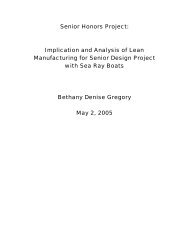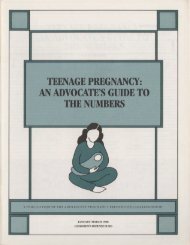child care - Digital Library Collections
child care - Digital Library Collections
child care - Digital Library Collections
You also want an ePaper? Increase the reach of your titles
YUMPU automatically turns print PDFs into web optimized ePapers that Google loves.
CHILD<br />
CARE<br />
of three <strong>care</strong>givers had annual earnings below the<br />
poverty line for a family offour.<br />
Current issues. Although more resources are<br />
now available to families, many of the problems<br />
highlighted in Windows on Day Care in 1972 remain<br />
just as challenging today. National studies<br />
continue to reveal alarming deficiencies in the<br />
quality of <strong>care</strong> in many communities. According to<br />
Cost, Quality, and Child Outcomes in Child Care<br />
Centers, a 1995 study conducted by researchers at<br />
the University of Colorado at Denver, the University<br />
of California at Los Angeles, the University of<br />
North Carolina at Chapel Hill, and Yale University,<br />
six out ofseven <strong>child</strong> <strong>care</strong> centers provide <strong>care</strong><br />
that is mediocre to poor. One in eight might actually<br />
be jeopardizing <strong>child</strong>ren's safety and development.<br />
Equally disturbing problems in home-based<br />
<strong>care</strong> were documented by Ellen Galinsky and others<br />
in a 1994 report for the Families and Work<br />
Institute. According to their Study of Children in<br />
Family Child Care and Relative Care: Highlights of<br />
Findings, one in three settings provided <strong>care</strong> that<br />
could conceivably hinder a <strong>child</strong>'s development.<br />
Low wages continue to be the norm for <strong>child</strong><br />
<strong>care</strong> providers, just as they were 25 years ago. Child<br />
<strong>care</strong> teachers and providers today earn less per year<br />
than the average bus driver ($20,150) or garbage<br />
collector ($18,100). Staff employed in <strong>child</strong> <strong>care</strong><br />
centers typically earn about $12,000 per year (only<br />
slightly above minimum wage) and receive no<br />
benefits or paid leave. As a result, turnover among<br />
<strong>child</strong> <strong>care</strong> providers is high, shattering the stable<br />
relationship that infants and <strong>child</strong>ren need to feel<br />
safe and secure.<br />
In addition, many states have woefully inadequate<br />
health and safety standards for <strong>child</strong> <strong>care</strong>.<br />
Staff education and training are among the most<br />
critical elements in improving <strong>child</strong>ren's experiences<br />
in <strong>child</strong> <strong>care</strong>. Yet 39 states and the District of<br />
Columbia do not require prior training for providers<br />
who look after <strong>child</strong>ren in their homes, and 32<br />
states do not demand prior training for teachers in<br />
<strong>child</strong> <strong>care</strong> centers (see figures 3.1 and 3.2). In<br />
contrast, becoming a licensed haircutter or manicurist<br />
typically requires about 1,500 hours of training<br />
at an accredited school.<br />
Even the standards that are in place are often<br />
poorly enforced because of a growing number of<br />
<strong>child</strong> <strong>care</strong> facilities coupled with insufficient inspection<br />
staff. A 1994 Inspector General's report<br />
on licensed <strong>child</strong> <strong>care</strong> centers in five states found<br />
Facts<br />
• Every day, 13 million <strong>child</strong>ren-including 6 million infants and<br />
toddlers-ore in <strong>child</strong> core.<br />
• Two-thirds of mothers of young <strong>child</strong>ren work outside the home-many<br />
out of economic necessity. Fifty-five percent of working women provide<br />
half or more of their family's income.<br />
• Half of American parents with young <strong>child</strong>ren earn less than $35,000<br />
per year, and two parents working full-time at minimum wage earn<br />
only $21,400 per year. Yet <strong>child</strong> core can easily cost $4,000 to<br />
$10,000 for a single <strong>child</strong>.<br />
• Forty percent of infant and toddler rooms in centers provide core that<br />
could jeopardize <strong>child</strong>ren's safety and development.<br />
Figures<br />
• Thirty-two states require no prior training for <strong>child</strong> <strong>care</strong> teachers. They<br />
are among the lowest-paid workers in America, earning only $12,058<br />
per year, on overage, and receiving no benefits or paid leave.<br />
• Juvenile crime peaks between 3 and 7 p.m., when nearly 5 million<br />
<strong>child</strong>ren are left home alone after school.<br />
CHI L D R EN'S D E FEN S E FUN D 39














